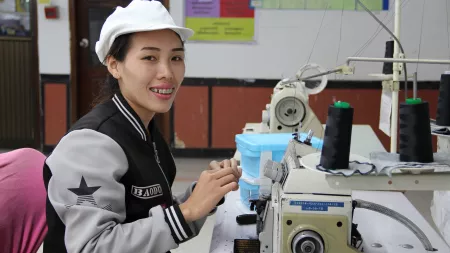LAOS Tackling bird flu
When the latest avian influenza outbreak hit northern Laos this month, a local veterinarian picked up the phone and called the new national avian influenza hotline.

 Asia and the Pacific
Asia and the Pacific
Laos ranks 137 out of 189 on the Human Development Index (HDI). CARE International’s work focuses on helping communities become more resilient to climate disasters, increasing access to markets and government services, and empowering marginalized women in Laos.
CARE International first began working in Laos in 1954. In 1975, the country faced a civil war that many communities are still recovering from.
While achievements in economic growth and poverty reduction in Laos have been impressive in recent years, rural poverty remains a major challenge. Laos is one of the most ethnically diverse countries in Southeast Asia, with 49 officially recognized ethnic groups and hundreds of sub-groups. Many people who live in remote rural areas in Laos belong to diverse ethnic groups and, although complex, there is a strong link between poverty and ethnicity. Women in Laos ethnic communities can face especially high barriers to economic empowerment.
CARE Laos’ demining program works alongside communities to safely remove the thousands of unexploded bombs left over from the civil war. This helps free up new areas for land and economic development.
We work closely with rural communities to support the construction of irrigation systems, providing training on efficient farming methods such as wetland rice cultivation, helping commercialize Laos wild tea, training volunteers in basic veterinary services, and increasing access to markets and government services.
CARE Laos also focuses on empowering marginalized women through developing policies and services to prevent gender-based violence and working with female garment workers to fight sexual harassment in the workplace.
Laos often faces small-scale natural disasters, especially floods, landslides, and droughts, which significantly impacts the country’s agriculture and economy. Some of CARE Laos’ work in the country focuses on helping communities become more resilient to disasters related to the climate emergency.
When the latest avian influenza outbreak hit northern Laos this month, a local veterinarian picked up the phone and called the new national avian influenza hotline.

Northern Uplands Promoting Climate Resilience was funded by the EU in Laos for $2.7 million. Between 2014 and 2018 it reached 2,460 people directly and 17,220 people indirectly. The project partnered with the Comite de Cooperation avec le Laos (CCL) and SAEDA.
Mrs Kiang makes her way down to the river with a blue mosquito net hanging over her shoulder. ‘What have you got that for?’ Noi, part of the CARE team assessing the area in Laos, asks her. ‘I found it and am going to wash it in the river and then use it,’ Mrs Kiang replies. ‘How did you know where to look?’ we ask, indicating the rubble all around. ‘That was my house,’ she says, pointing at a huge pile of wood and tree branches we’re staring at.
As we waited for Typhoon Ketsana to hit, our first priority was the safety of our staff. Any at risk were immediately called back and commonsense things like closing windows and doors, making sure we had enough drinking water and ensuring that our staff prepared their own houses were done so we were ready to concentrate on people’s needs as soon as the storm passed.
In FY2023, CARE worked around the world, contributing to saving lives, fighting poverty, and increasing social justice.